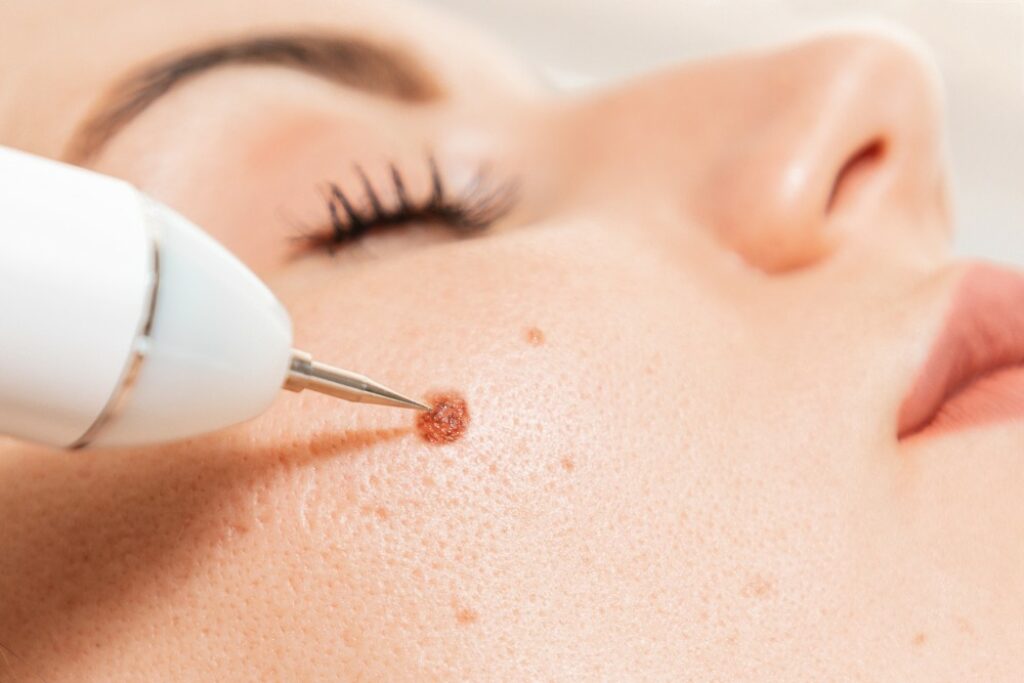
Birthmark Removal
Some people consider birthmarks to be a thing of beauty. Others believe it’s a sign that you were kissed by an angel. But if it’s dark and noticeable and you want to get rid of it, there are ways to achieve this with birthmark removal treatments.
Related Topics (Sponsored Ads):
Birthmarks are common skin markings that can vary in color, size, and shape. They can appear anywhere on the body, but they commonly appear on the face. While many birthmarks are harmless and fade over time, some individuals may seek birthmark removal for medical or cosmetic reasons. There are several treatment options available that will lighten the marking, thus achieving a more desired appearance. But there are some things you should know about before going ahead with it.
This article will explore the various methods and considerations for birthmark removal, including surgical and non-surgical procedures, potential benefits and drawbacks, recovery and aftercare, and self-help methods.

Overview of Birthmarks
Birthmarks are areas on or under the skin that have a different color or appearance than the surrounding skin. They can be present at birth or develop in the weeks following birth. There are two main types of birthmarks: vascular birthmarks and pigmented birthmarks. Vascular birthmarks result from blood vessels that are abnormal in size, number, or location, while pigmented birthmarks are caused by an overgrowth of pigment cells.
Common types of birthmarks include hemangiomas, port wine stains, moles, and café au lait spots. While most birthmarks are benign and do not require removal, some individuals may consider birthmark removal for cosmetic reasons or if the birthmark poses a medical concern.
Laser Treatment
Laser therapy is a non-invasive procedure that can be effective for lightening or reducing the appearance of certain birthmarks, particularly vascular birthmarks such as port wine stains. During laser therapy, a dermatologist uses a focused beam of light to target and shrink blood vessels or pigment cells, making the birthmark less noticeable.
The procedure may cause temporary redness, swelling, or discoloration, and multiple sessions may be required for optimal results. While laser therapy can be effective for certain birthmarks, it may not completely eliminate the birthmark, and results may vary.
Cryotherapy
Cryotherapy involves the use of supercooled liquid nitrogen to freeze and remove birthmarks. This method is particularly suitable for smaller birthmarks and can be effective for certain types of pigmented birthmarks. This is a relatively quick procedure and may cause minimal discomfort. However, it may not be suitable for all types of birthmarks, and scarring is a potential risk.
Excision Surgery
For larger or more prominent birthmarks, excision surgery may be recommended. During excision surgery, a dermatologist surgically removes the birthmark using a scalpel. The procedure may require local or general anesthesia, depending on the size and location of the birthmark. While excision surgery can provide permanent removal of the birthmark, scarring is a potential outcome, and recovery time may be longer compared to non-surgical procedures.
Considerations, Benefits and Drawbacks
The suitability of each removal procedure depends on the type, size, and location of the birthmark. Laser therapy is often preferred for vascular birthmarks, while excision surgery may be more suitable for larger or raised pigmented birthmarks. It is essential to consult with a dermatologist or healthcare professional to determine the most appropriate treatment option based on the specific characteristics of the birthmark.
Each birthmark removal option has its own set of potential benefits and drawbacks. Laser therapy and cryotherapy are less invasive and typically involve minimal downtime, but they may not be suitable for all types of birthmarks. Excision surgery offers permanent removal but carries a risk of scarring and requires a longer recovery period. Understanding the potential outcomes and risks associated with each procedure is crucial in making an informed decision.
Recovery and Aftercare
The recovery and aftercare requirements following birthmark removal vary depending on the chosen procedure. After laser therapy, individuals may experience temporary redness, swelling, or peeling, and it is essential to protect the treated area from sun exposure.
Following excision surgery, proper wound care and adherence to post-operative instructions are vital for optimal healing and to minimize the risk of scarring. It is important to discuss post-procedure care with the healthcare provider to ensure a smooth recovery.
Self-Help Methods and Home Remedies
While home remedies and self-help methods may not completely remove a birthmark, they may help manage or reduce its appearance. These methods include applying topical vitamin E, avoiding sun exposure, and maintaining overall skin health. It is important to note that home remedies should be used under the guidance of a healthcare professional, and they may not be suitable for all types of birthmarks.
Final Thoughts
In summary, birthmark removal procedures offer various options for individuals seeking to minimize or eliminate the appearance of birthmarks. Whether considering laser therapy, cryotherapy, or excision surgery, it is crucial to weigh the potential benefits and drawbacks of each procedure and consult with a healthcare professional to determine the most suitable approach based on the type, size, and location of the birthmark.
Additionally, understanding the recovery and aftercare requirements for each procedure, as well as exploring self-help methods and home remedies, can contribute to a well-informed decision-making process. Ultimately, the decision to pursue birthmark removal is a personal one that should be made in collaboration with a healthcare provider. With careful consideration and professional guidance, you’ll have that birthmark gone in no time.




